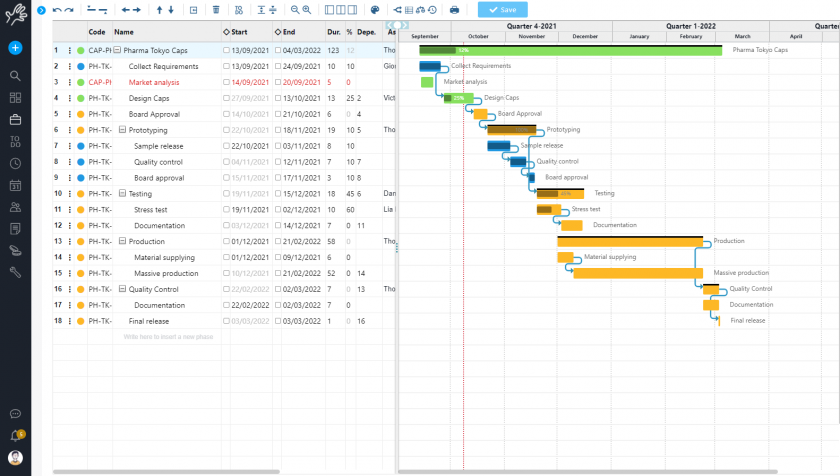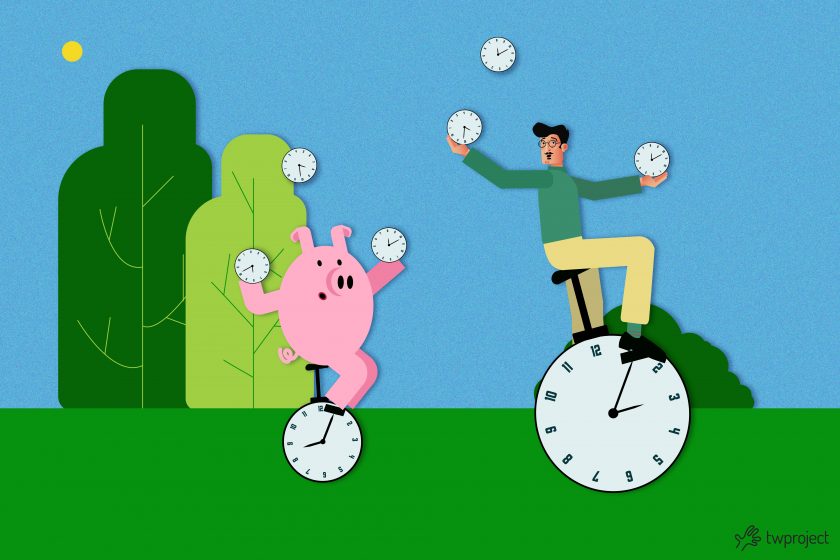Knowing the best time planning strategies is important to execute your work to the best of your ability.
Time is not on your side when it comes to project management, when work piles up and deadlines approach quickly.
Project time management involves planning, scheduling, monitoring, and controlling activities throughout the project life cycle.
In this article, we will discuss how to make the most of time and the best time-planning strategies.
CONTENT
- Why is time management so important in a project?
- 5 time planning strategies in project management
- 1.Have a well-defined project plan
- 2.Estimating time accurately
- 3.Involving and communicating effectively with stakeholders
- 4.Remaining flexible
- 5.Developing a proper work breakdown structure
- 6.Avoiding unnecessary meetings
- Time planning: make the most of your time thanks to Twproject
Why is time management so important in a project?
Projects can be intimidating as there is much to do with limited time, and stakeholders don’t like delays.
Successful project time management allows you to split the work into more manageable parts by assigning each task to a precise time sequence.
This partitioning is critical to identify and separate the important tasks from the urgent and less urgent tasks. Often, pressure to complete urgent tasks can lead to neglecting those that are more strategic and pivotal to the project’s long-term success. Hence, it is vital to clearly understand priorities and devote the right amount of time to each task.
Efficient time management involves meeting deadlines and influencing the quality of work, team satisfaction, and customer perception.
Sapere quando dire di no a richieste che non aggiungono valore al progetto o che possono essere un’inutile distrazione è una competenza chiave. Often, to avoid being overwhelmed and to meet time constraints, a project manager must know how to reject new tasks or to redistribute tasks within their team.
6 time planning strategies in project management
Successful time management is one of the most vital skills for a project manager.
In a business environment where pressing deadlines and high expectations are standard, knowing how to plan and manage time can make the difference between a project’s success and failure.
Each project has its own challenges and peculiarities, but there are proven strategies that can help optimize time use and ensure that all tasks are completed on time and with the required quality.
Below, we will discuss five key time planning strategies in project management that will help you better manage your time and improve your overall efficiency.
These strategies will help you keep your schedule constraints under control and keep your focus on priorities.
1. Have a well-defined project plan
A well-defined project plan positively impacts all project stages from start to finish.
It is the building block for the entire project management process.
Without a clear roadmap, it is easy to lose track of priorities, waste time on non-essential activities, and find yourself dealing with emergencies that could be avoided with careful planning.
When you execute something without a clear idea, you waste a lot of time discussing what to do, how to do it, etc. This chaotic approach is often the main cause of time abuse in a project.
Therefore, it becomes essential to invest time initially in defining a proper project plan. In this way, the project manager not only conducts a productive conversation with stakeholders that will define the structure of the project to come but can also take active steps to eliminate many of the common time-wasters that might occur.

2. Estimating time accurately
Realistic time estimation is critical to creating a feasible program. Here are some tips for improving the accuracy of estimates:
- Break down activities into even smaller tasks: The smaller the task, the easier it will be to estimate the time needed to complete it. To-Do Lists are simple yet powerful tools that can be very helpful in breaking down specific activities into smaller, more manageable tasks.
- Consider your experience: If you have previously worked on similar projects, use your knowledge to estimate the time required for similar activities.
- Seek advice from experts: Discuss with other team members experienced in specific project areas to get their estimates.
- Use estimation techniques: Several estimation techniques, such as the Delphi Method or Planning Poker, can help achieve more accurate estimates.
- Add time buffer: It is always best to slightly overestimate the time needed rather than underestimate it. To account for unforeseen contingencies, add a 20-30% buffer to your estimates.
3. Involving and communicating effectively with stakeholders
Some of the major time-related problems that project managers face are communication delays.
Finding ways to keep all stakeholders engaged in communication is the best way to keep them involved in the project. Thus, it is essential to establish clear and preferred communication channels for each stakeholder.
Some prefer e-mail updates, while others prefer face-to-face meetings or video conferences. Adapting to stakeholders’ preferred communication channels helps ensure that information is properly received and understood.
This allows you to spot any concerns or changes in priorities by stakeholders in good time and act accordingly.
Sending regular weekly or monthly e-mails with an overview of activities carried out is one of the most frequently used approaches. Sending regular updates, such as weekly or monthly reports, helps keep everyone on track and promptly identify any problems or shifts in priorities.
These updates should include information on important and urgent tasks, upcoming deadlines, and any issues encountered.
4. Remaining flexible
When actively workoing on projects, especially large ones, unexpected contingencies can always be around the corner. For this reason, project managers must approach every situation with flexibility and adaptability. They should be able to work around priorities and deal with problems as they arise, without losing sight of the original project.
Yet despite the obvious benefits of being flexible, in some situations, project managers should encourage their team to stick to the plan, even in particularly stressful times. It is always up to the project manager to determine which scenarios require a rigorous process and which require flexibility.
Regardless of the approach, the coordinator must always consider the project timeline when making decisions.
5. Developing a proper work breakdown structure
Breaking down the large end results of a project into manageable and measurable tasks helps to manage time efficiently.
This process of splitting larger tasks into smaller, easier-to-manage tasks can be completed more effectively through the development of a “work breakdown structure” (WBS).
By relying on such a structure, time wasted can be minimized as well as helping to reduce the stress that accompanies large-scale end results.
Let’s see what the steps are to create a WBS:
- Breakdown into deliverables: The first step in creating a WBS is to identify the main deliverables of your project. These are the concrete deliverables that the project must produce. Once identified, each deliverable can be additionally broken down into smaller, more manageable activities. This breakdown helps clarify what needs to be done to complete each part of the project and keep the focus on important tasks.
- Task definition: Every deliverable and sub-deliverable is broken down into specific tasks. These tasks must be outlined clearly, with precise objectives and defined completion criteria. Urgent tasks must be identified and managed carefully to ensure they do not compromise project progress. Clarity in task definition helps prevent confusion and keep the team aligned.
- Responsibility allocation: After tasks have been defined, it is important to assign responsibilities for each task to team members. Each task should have a clearly identified manager who will be assigned to ensure that the task is completed within the set schedule. Such allocation of responsibility helps to keep the team motivated and accountable.
- Activity sequencing: Task sequencing within the WBS is crucial to ensure that work proceeds logically and efficiently. Some tasks may run in parallel, while others must be completed sequentially. Identifying these dependencies helps prevent bottlenecks and keep the project on schedule.
- Time and resource estimation: Every task in the WBS must have an estimate of the time and resources required for completion. This estimate must be both realistic and based on an accurate assessment of the project’s needs. Accurate estimates are key to preventing delays and work overloads. Assigning realistic time limits for each task helps keep the project in check.
- Regular monitoring and updating: WBS is not a static document. It must be monitored and updated regularly to reflect project progress and address any changes or contingencies properly. Constant monitoring allows any deviations from the original plan to be identified early and corrective measures to be taken. This dynamic process helps keep the project aligned with initial goals and on schedule.
Project management tools and software such as Twproject can smooth WBS development and management. This software helps to create, visualize and update the WBS effectively. This offers advanced features for managing dependencies, monitoring progress and communicating with the team.
6. Avoiding unnecessary meetings
Unnecessary meetings are among the most common time-wasters in projects in all sectors. They could be meetings that were scheduled at the beginning of a project but have become progressively less necessary over time.
Whatever the format, these unnecessary meetings can cause a great waste of time, and it is the project manager’s responsibility to identify and change or eliminate them.
In the case of necessary meetings, it is critical to establish an agenda before the meeting so that everyone knows what exactly needs to be addressed during the meeting.
Time planning: make the most of your time thanks to Twproject
We discussed how efficient time planning is crucial in project management.
It is clear that the project manager cannot coordinate everything themselves but must use an appropriate tool.
Twproject, one of the best project management software available, can provide the exact kind of support a project coordinator needs. It provides real-time data to track time spent on each task and resource, allowing progress to be monitored in real-time.
Moreover, it helps arrange all activities on a Gantt chart, identify dependencies, and set optimal time sequences.

This way, you will be able to find out immediately if your project is going off track. In a nutshell, using software such as Twproject will allow you to:
- Enhance the productivity of your whole team;
- Identify and perform assigned tasks more easily;
- Having more time at your disposal;
- Significantly reduce work stress.
Twproject is highly adaptable and scalable, making it a great fit for projects of any size and complexity. Whether your team is a small one working on a short project or a large group spread across multiple long-term projects, Twproject can be configured to meet the specific needs of your team and project.
Boasting advanced features for task management, project time and resource tracking, communication, and reporting, Twproject enables project managers to always be in complete control of your project, improving productivity and reducing work stress.




